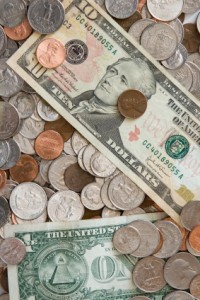 Student credit cards are fairly easy to get, simply because credit card issuers view high school and college students as a segment of the population with money to spend. Of course if you’re the parent of student, you know that may or may not be true.
Student credit cards are fairly easy to get, simply because credit card issuers view high school and college students as a segment of the population with money to spend. Of course if you’re the parent of student, you know that may or may not be true.
What is true is that even when not required to co-sign for the student credit card, parents will generally back their youngsters and pay the bills when the kids can’t. So parents need to spend time discussing the use of the card – and setting some rules of their own.
Students do often need to have access to money for unexpected expenses. A professor may demand an extra textbook or they may become ill and need to have a prescription filled in a hurry. They may even need funds for transportation back to school after an ill-advised side trip with other students. (We’ve all done silly things, after all!)
But unless you’ve set up the student credit card as a way to access to a pre-set allowance for the student, using the card for day to day expenses should be out of the question. The student should view his or her student credit card as a safety net and use it only for emergencies. And contrary to some beliefs, needing a few new CD’s or a pizza are not emergencies.
If your child handles it responsibly, that student credit card will help him or her begin to build a solid credit rating. On the other hand, irresponsible use will cause him to begin his working life with the handicap of low credit scores.
And unless you’re stepping in to pay all the bills, it can also cause him to carry a heavy burden of debt. Over-limit fees and late fees on student credit cards can be excessively high, so that $20 pizza that pushes the card over-limit could end up costing $50 or even $60! Plus interest, of course.
If your student is paying his or her own bills – either via money you provide as an allowance or from a part-time job – impress upon him that his student credit card bill must be paid on time. If he’s going to be short and unable to pay it, he needs to call home before the due date, even if it’s embarrassing. Late fees are already hovering at the $40 mark, and could go higher as credit card issuers seek to expand their profits.
 If high interest rates on current credit card balances are getting you down, it’s time for a switch to Bryant State Bank Mastercard®. With a low introductory APR of only 3.25%, you can get those balances paid down quickly.
If high interest rates on current credit card balances are getting you down, it’s time for a switch to Bryant State Bank Mastercard®. With a low introductory APR of only 3.25%, you can get those balances paid down quickly.
While other banks charge up to 5% up front just to transfer your balance, Bryant State does not charge a balance transfer fee on your initial transfer. That means your interest rate savings are real savings – money you can use to pay down or pay off your balances.
And, even if you don’t quite get the balance paid off, when the introductory rate expires after 6 months, you’ll still be paying a low rate – only 11.25%.*
When you carry the Bryant State Bank Mastercard® you’re also protected by zero percent fraud liability, and access to emergency cash advances and card replacement should your card be lost while traveling – either in the United States or abroad.
Of course you’ll have access to all your account information on line 24 hours a day. From here you can check balances, make payments, and view your transactions.
The annual fee for this card is a low $20 and you can add additional users for $10.
Your eligibility for this and any credit card is based upon your credit standing at the time of application. To see where you stand right now, and make sure that there are no errors that could lower your credit rating, get your free credit report today.
Before choosing any credit card, be sure to compare offers and terms. You’ll find a wide selection of credit card offers right here, so stay a while and look around.
* Annual percentage rate is variable, based on the prime rate. Interest rate subject to change in the event of non-payment. See our complete terms for full details.
 You’ve heard that one of the factors considered in calculating your credit scores is the length of time you’ve had an account – be it a credit card, mortgage, car loan, or retail account. You’ve also heard that closing one credit card account and opening another can pull your scores down.
You’ve heard that one of the factors considered in calculating your credit scores is the length of time you’ve had an account – be it a credit card, mortgage, car loan, or retail account. You’ve also heard that closing one credit card account and opening another can pull your scores down.
So what if you lose your card and have to get a new account number to prevent unauthorized use? Or what if you’ve been a victim of one of the recent security breach incidents?
Breathe easy – those reasons for closing a credit card account and opening a new one won’t hurt your credit scores.
In fact, it won’t even be treated as a new account. Instead, your credit card issuer will transfer all of your information from the old account to the new one, which will be opened simultaneously. The new account will carry the same opening date, interest rate, credit limit, and payment history.
When your credit card issuer reports the change to the credit bureaus they may or may not show a closed account and a new account. Instead they may simply report a change in account numbers.
Closing an account to change to a different kind of account can lower your scores.
You may want a credit line increase, or you may want to switch from a standard card to a rewards credit card. Or, you may feel it’s time to switch from a student credit card to a standard card or rewards card. These actions could lower your scores.
Instead of closing the account that has “history,” consider keeping it and making application for a second card. This could be an especially good move if you want a rewards credit card to use for a purpose that will accompany payment in full each month – for instance, to charge gasoline for which you’ll be reimbursed by your employer.
By keeping your rewards credit card charges separate from a card that carries a balance, and paying it in full each month, you’ll avoid paying any interest on those charges.
You should also hang on to your student credit card for the time being. Keep it and use it occasionally to keep the account open until you’ve built a history with your new card. Even if that student credit card carried high interest, you won’t be paying it if you charge small amounts and pay the balance in full each month.
 The Urban Trust Success Prepaid Visa® Card offers a cost-effective alternative to the high cost of check cashing, while allowing consumers without checking accounts to access their funds easily.
The Urban Trust Success Prepaid Visa® Card offers a cost-effective alternative to the high cost of check cashing, while allowing consumers without checking accounts to access their funds easily.
Using this card enables on line shopping and bill paying, and such activities as reserving a hotel room or car rental.
When you opt in to have paychecks directly deposited to your account, you’ll have immediate access everywhere Visa debit cards are accepted. That includes cash withdrawals at virtually any ATM 24 hours a day. And, with Visa’s Zero Liability policy, it’s much safer than carrying cash.
Unlike a secured credit card, with a prepaid Visa card there are no monthly statements or bills to pay.
Obtaining a prepaid debit card does not require a credit check. However, all applicants are subject to compliance with the USA PATRIOT Act and OFAC.
You will have access to account information on line 24 hours a day, as well as through the dial-in voice activated response system. Here you can check balances and recent transactions, and change your pin numbers. Speaking with a customer representative may carry a fee.
Monthly statements are available on line at no charge – paper statements may be requested and do carry a fee. You will be charged a $4.95 activation fee and a monthly fee of $4.95. Direct deposits to your card are free, but retailers may charge a fee to reload your card. You will be charged a $2.50 fee for making withdrawals through an ATM and the ATM owner may charge an additional fee.
Urban Trust Success Prepaid Visa® Card holders are eligible to apply for an additional line of credit up to $500.
The prepaid Visa is a great way to enjoy the convenience of a credit card when you’re getting over the effects of a poor credit history.
But of course good credit is a goal to aspire to. To keep track of how you’re doing as you rebuild your credit, get your free credit report today.
 Do you read the fine print on your credit card bill? Did you read the fine print when you accepted the credit card in the first place?
Do you read the fine print on your credit card bill? Did you read the fine print when you accepted the credit card in the first place?
If you’re like most people, you didn’t. You probably noticed that the interest rate charged on purchases is different from the rate on cash advances. Sometimes the cash advance came with a low promotional fee, so it was charged at a rate such as 5.9% while purchases remained at 12.9% or even higher.
Unless you did read the fine print, you probably didn’t notice that your payments all went toward paying down the lower interest balance, rather than being allocated proportionately between them or applied to the higher interest balance.
Under the new Credit Cardholder’s Bill of Rights, that will change. Your minimum payment will still be allocated to the lowest interest rate balance, but any amounts you pay above the minimum will be credited toward your high interest balance. So if you accidentally use the wrong card and charge $50 in high interest purchases on a card that you planned on only using for cash advances, you can hurry and pay $50 over your minimum payment to get rid of the high interest.
The new law also bans a practice that you probably didn’t realize was being done. This practice, known as double-cycle billing, based your finance charges on the average balance of both the current and the previous month’s balance. So even if you made a large payment and brought your balance down considerably, you’d still be paying interest on that paid debt the next month.
A third consumer-friendly provision goes into effect in just two months – in August 2009. This provision requires credit card issuers to mail your statement 21 days in advance of your due date, as opposed to the current 14 days. The shorter time frame was causing many consumers to receive their statements too late to write a check and return it in time for it to get back to the card issuer before the due date.
Gift cards will also be regulated under the new laws. Beginning in August 2010, all gift cards must be valid for at least 5 years – allowing consumers plenty of time to use them. Also, while at present the issuer can assess inactivity fees if the card is not used for a short time, they will now not be permitted to assess such fees unless the card has gone unused for 12 months.
 Approval is guaranteed with a Next Millennium Visa® Credit Card. In fact, no credit check is required, because this is a secured card.
Approval is guaranteed with a Next Millennium Visa® Credit Card. In fact, no credit check is required, because this is a secured card.
This is a perfect credit card for those who have had financial difficulties and need to rebuild their credit, because your on-time payments are reported to all 3 major credit reporting bureaus. It’s also the perfect card for anyone who has not had credit in the past and needs to establish accounts in order to build a credit file.
The funds you deposit to secure your credit card are FDIC insured for your safety. You can choose any amount between $300 and $5,000 to secure this credit card.
Our APR of 19.9% is low by current standards, as is our over-limit and late fee of only $20. With a setup fee of $99 and an annual fee of $59, there’s no reason not to begin rebuilding your credit today.
The Next Millennium Visa® Credit Card is accepted everywhere that Visa® is accepted, and you can access cash at over 740,000 ATM’s worldwide – so you’ll enjoy the same convenience that you would with a traditional credit card. You will once again be free to make purchases and pay bills on line.
With our online account access, you can keep track of your spending and view your transactions without having to wait for a paper statement.
 “Take care of your pennies and the dollars will take care of themselves” is an old adage, and it applies to these techniques for paying down your credit card debt.
“Take care of your pennies and the dollars will take care of themselves” is an old adage, and it applies to these techniques for paying down your credit card debt.
You may not realize it, but each month that you carry a balance, you pay interest on the “average daily balance” on your credit card. In addition, interest begins accruing from the date of your last statement, so your average daily balance every day thereafter includes that interest.
Thus, the sooner you make that payment, the lower your average daily balance, and the less interest you’ll pay.
If, for example, you have a balance of $10,000 and you’re paying an 18% annual percentage rate. If you make a $350 payment on the last day of the billing cycle, you’ll pay interest on an average daily balance of $9,989. However, if you pay on day 2 of the billing cycle, your average daily balance falls to $9,661.
At 18% per anum, you’re paying 1.5% per month, so your interest if you wait to pay until the last day will amount to $149.83, while your interest if you’d paid on the 2nd day would be only $144.91. That’s a savings of about $5 per month.
It’s not huge, but over the course of a year it’s $60 that you could have used to pay down your debt or take care of some other obligation.
A second trick is to make a habit of making “micropayments.”
Say you worked some overtime one week and saw a little bump in your paycheck. Instead of letting that extra money flow into your general spending, go straight to your credit card account on line and make a micropayment.
You could do the same if you happened on some high value store coupons or found a sale on grocery items you buy regularly. Figure the savings, then go apply it to your balance. Even if you only pay $5 at a time, it will add up.
Remember, each time you make one of these unscheduled micropayments, you’re reducing your average daily balance – which means your balance is reduced by the amount of the payment, plus the amount of the interest that would have accrued.
At 18%, the interest on $100 for 15 days is seventy-five cents. Not much, you say? No, it isn’t, but when you consider that you’ve paid that $100 and you won’t pay interest on it again next month or the month after that, it begins to add up fast.
Of course, this will only benefit you if you continue making your regularly scheduled payments.
 Orchard Bank Classic Mastercards® provide you with the opportunity to establish better credit, while enjoying all the conveniences of a traditional credit card.
Orchard Bank Classic Mastercards® provide you with the opportunity to establish better credit, while enjoying all the conveniences of a traditional credit card.
Because we report to all 3 major credit bureaus, your good payment record builds your credit rating each month, and with your ability to choose your own payment date, you can be assured that your payment will come due after your paycheck arrives.
Orchard Bank Classic Mastercards® are accepted at millions of locations worldwide, including Internet stores and reservations desks across the country. In addition, you can get discounts from many of your favorite merchants when you enroll in the services offered at www.mcnearby.com.
It’s easy to manage your finances any time of the day or night with our Account Management Tools and Online Bill Pay.
When you enroll for online management, you can even request email or text messages to remind you of your upcoming payment due date and let you know when you’re approaching your available balance limit.
Keeping track of your spending is easy. Our system allows you to sort your credit card transactions by date, amount, description or category, and we store 12 month’s worth of transactions for you – making it easy to review your activity for the past year and catch any of those deductible transactions that you’ll need for tax time.
Of course you can view transactions since your last statement, and speak to a trained Customer Service Representative when you have questions.
You can view and download up to a year’s worth of PDF statements, and download your transactions directly into MS Money or Quicken – saving you from that time consuming data entry and assuring that you didn’t miss an expense.
Interest rates range from a variable 14.9% to 19.9%, with a default rate of a variable 29.49% Annual fees range from $35 to $79, and the processing fee to open your account ranges from $0 to $49.
 Guarding your credit card against theft is a first defense against identity theft, yet many people leave their cards where a thief can easily have access.
Guarding your credit card against theft is a first defense against identity theft, yet many people leave their cards where a thief can easily have access.
Do you do any of these things:
- Leave your credit card in a desk drawer at home?
- Leave your credit card in a “handy” spot – like the kitchen cupboard or the top of your dresser?
- Leave your credit card in your purse or wallet in your car?
- Leave your credit card in a gym locker?
- Leave your purse in a grocery cart while you go into a cooler?
- Leave your credit card in your purse on a restaurant chair while you get up to visit the salad bar?
- Leave your credit card in your pocket or purse when you’re in a night club and get up to dance?
- Leave your wallet laying on the checkout counter while you run back to get a missed item?
If you do any of those things, you’re inviting theft.
You may think your cards are perfectly safe at home – and they probably are, unless you’re burglarized. If that happens, finding your card is like finding a gold mine – although your thief will have to act quickly if they’ve made a mess of your home.
Those other “loss spots” can be even more dangerous. Because you may not use your card every day, you might not notice the loss immediately. That gives your thief time to use the card extensively, as well as use it as a guide to stealing your identity.
One other danger spot that most people don’t even think about is restaurants. Most of the time, when you use your card, you either scan it yourself or the clerk does it while you’re standing right there, watching. But when you go to a restaurant, the practice is usually different.
First, the wait person brings your check – if it’s an upscale establishment, it will be in a tasteful fold-over binder. You then place your card in the binder and that person takes it away to process. And that’s where the danger lies.
It takes only seconds to photograph both sides – thus the thief has your numbers, your expiration date, the code on the back, and a copy of your signature. And you have no clue that anything has been done until you begin getting bills with strange charges.
It wouldn’t even occur to the majority of restaurant personnel to do such a thing, but all it takes is one to ruin your day. Or rather, a lot of your days. Because you don’t know about the theft, you won’t report it immediately, so you’ll be in the position of proving that a lot of fraudulent charges weren’t yours.
That’s easy enough if they leave town, but if they happen to live in your neighborhood, you’ve got a bigger problem.
What can you do? Wait to pay the bill until you’re leaving the restaurant. Then take it to the counter and pay it in person. A little inconvenient, yes, but worth the safety.
One more thing about restaurant charges – they usually include a space to add in a “gratuity.” If you prefer to leave cash on the table for your server, make it a habit to enter a zero in that spot and bring the total down to the bottom line. If you don’t, a dishonest person can fill in any amount they choose.
 The Upromise® World MasterCard® credit card is the card to choose when you’re saving for college or paying off student loans.
The Upromise® World MasterCard® credit card is the card to choose when you’re saving for college or paying off student loans.
Every time you use your credit card to shop with a Upromise partner, a percentage of your purchase goes into your Upromise account, where it continues to grow until you use it to pay down your college loans or pay for current college expenses. It can be used to cover your own expenses, or it can be a college savings account for your child. With no annual fee and no application fee, using this card is pure savings.
Even better, it’s tax-free and others can join and contribute. What better way for Grandma and Grandpa to help fund your child’s college education.
You’ve probably seen similar savings programs that limited you to a few vendors – many of them not even in your community. Upromise is different – our partners include over 700 on-line stores, over 8,000 restaurants, and more than 22,000 drug and grocery stores nationwide. And they’re names you know – like McDonalds, Target.com, Exxon Mobil, Gap, Sears, J.C. Penny, eBay, Barnes & Noble, Ace Hardware, Coldwater Creek, Office Depot, Walgreens, and Best Buy.
So whether you’re using your credit card for shopping online, buying groceries, filling the gas tank, eating out, or booking travel, you’ll be saving money doing the things you’d normally do. Visit our site to get all the details and see the complete list of partners and eligible purchases.
Just to get your savings started, you’ll earn a $25 bonus with your first qualified purchase within 90 days of card activation, so why not apply today?
To be eligible you must have a credit record free of bankruptcy or any recent delinquencies, and a credit score of at least 700.
If you aren’t sure about your credit score, order your free credit report with scores right now and check. If you need to make some improvements before making application for , it will be worth the wait.
When you join, you’ll pay no interest for the first 7 to 10 statement periods, depending upon your credit scores. Then your interest rate, which is tied to the prime rate and can vary, will be between this credit card 12.99% and 20.99%.
 Student credit cards are fairly easy to get, simply because credit card issuers view high school and college students as a segment of the population with money to spend. Of course if you’re the parent of student, you know that may or may not be true.
Student credit cards are fairly easy to get, simply because credit card issuers view high school and college students as a segment of the population with money to spend. Of course if you’re the parent of student, you know that may or may not be true.





 Orchard Bank Classic Mastercards®
Orchard Bank Classic Mastercards®

